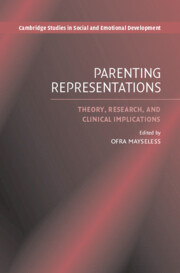Book contents
- Frontmatter
- Contents
- List of Illustrations
- List of Tables
- List of Appendixes
- List of Contributors
- Preface
- Acknowledgments
- Part One Theoretical Perspectives
- Part Two Research Applications
- Part Three Clinical Implications
- 9 Intergenerational Transmission of Dysregulated Maternal Caregiving: Mothers Describe Their Upbringing and Childrearing
- 10 Good Investments: Foster Parent Representations of Their Foster Children
- 11 Intergenerational Transmission of Experiences in Adolescence: The Challenges in Parenting Adolescents
- 12 Interplay of Relational Parent–Child Representations from a Psychoanalytic Perspective: An Analysis of Two Mother–Father–Child Triads
- 13 Why Do Inadequate Parents Do What They Do?
- Index
- Cambridge Studies in Social and Emotional Development
- References
13 - Why Do Inadequate Parents Do What They Do?
from Part Three - Clinical Implications
Published online by Cambridge University Press: 10 July 2009
- Frontmatter
- Contents
- List of Illustrations
- List of Tables
- List of Appendixes
- List of Contributors
- Preface
- Acknowledgments
- Part One Theoretical Perspectives
- Part Two Research Applications
- Part Three Clinical Implications
- 9 Intergenerational Transmission of Dysregulated Maternal Caregiving: Mothers Describe Their Upbringing and Childrearing
- 10 Good Investments: Foster Parent Representations of Their Foster Children
- 11 Intergenerational Transmission of Experiences in Adolescence: The Challenges in Parenting Adolescents
- 12 Interplay of Relational Parent–Child Representations from a Psychoanalytic Perspective: An Analysis of Two Mother–Father–Child Triads
- 13 Why Do Inadequate Parents Do What They Do?
- Index
- Cambridge Studies in Social and Emotional Development
- References
Summary
Abstract
Understanding why threatened parents behave in ways that seem, from the perspective of less threatened people, to exacerbate the risk to their children requires consideration of the process of generating and selecting among dispositional representational (DR) models. This chapter addresses six forms of DRs from a memory systems perspective (Schacter & Tulving, 1994). These are described in a developmental framework in which neurological maturation interacts with experience to generate developmental pathways. The outcome of the pathway, at any given moment, is an emergent, ever-changing set of DRs that both shape individuals' perception of the world and their relation to it and also guide the transformation of mental representations to enacted behavior. It is argued that preconscious memory systems regulate important aspects of parental behavior because they promote safety and that reflective, integrative, and verbal processes may be infrequent, especially among risk parents, because integrative processing itself can expose parents and their children to danger. The chapter points to the paradox that protection and preparation for reproduction, which are essential and universal components of parenting, appear to be precisely the functions that are distorted in cases of risk, that is, cases of child maltreatment and parental mental illness.
Everyone has seen parents treating their children in unacceptable ways and wondered why they did that. Everyone has been horrified at the “inhumanity” of parents whose abuse and neglect of their children has garnered media attention and wondered how they could do those things.
- Type
- Chapter
- Information
- Parenting RepresentationsTheory, Research, and Clinical Implications, pp. 388 - 434Publisher: Cambridge University PressPrint publication year: 2006
References
- 20
- Cited by



